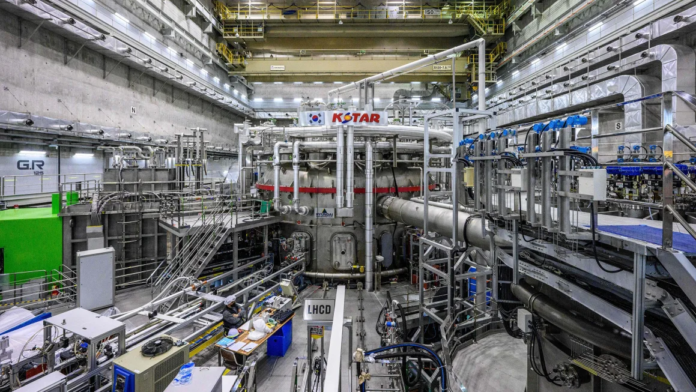
By Jessica A. Dennehy
The Korea Superconducting Tokamak Advanced Research device (KSTAR) at the Korea Institute of Fusion Energy, Credit: CNN)
Nuclear fusion, the reaction of stars, has long been hailed as the ideal clean energy source. The process of fusion occurs when two or more nuclei, typically involving isotopes of hydrogen, such as deuterium and tritium, combine to form different atomic nuclei and subatomic particles, typically helium particles, neutrons, and large amounts of energy. The release of energy is due to the difference of the masses of the reactants and products. Compared to current energy sources, the products are not only less harmful to the environment, but also highly valuable, as helium is currently being depleted at rates far greater than its synthesis and outside of fusion, can’t be man-made. Fusion would generate four times more energy per kilogram of fuel than fission (used in nuclear power plants) and nearly four million times more energy than burning fossil fuels. It would also not create radioactive waste, which is a large issue with nuclear fission, and removes the possibility of a possible nuclear meltdown. However, the current challenge with fusion is that the energy input exceeds the output. In theory, this would be completely solved if we were able to achieve “ignition,” or when the reaction becomes self-sustaining.
Fusion technology most commonly takes the form of a tokamak, a donut shaped reactor that heats up hydrogen or its isotopes to incredible temperatures and forms it into a plasma. Si-Woo Yoon, director of the KSTAR Research Center at the Korean Institute of Fusion Energy (KFE), notes that the current difficulty in sustaining the high temperatures comes from the “unstable nature of the high temperature plasma.” Therefore, sustaining plasma with temperatures of 100 million degrees, seven times hotter than the core of the sun, for any given amount of time is a remarkable feat. Previously, the record was set in 2021 at sustaining these temperatures for 30 seconds.
The KSTAR Research Center, home to the Korea Superconducting Tokamak Advanced Research device (KSTAR), better known as Korea’s “Artificial Sun,” has broken the record held for longest period of time plasma has remained at 100 million degrees with 48 seconds during tests between December 2023 and February 2024. Scientists say that by using tungsten as an alternative to carbon in the ‘diverters,’ which are responsible for extracting heat and other impurities produced by the reaction, they are much closer to their goal of sustaining plasma (at 100 million degrees) for 300 seconds by 2026. Si-Woo Yoon considers reaching this goal “a critical point” for the further scaling up fusion operations.
The field of nuclear fusion is rapidly evolving, with records being broken and historic milestones achieved every year. In 2022, American scientists at Lawrence Livermore National Laboratory’s National Ignition Facility successfully completed a nuclear fusion reaction with a greater output of energy than investment. In February 2024, scientists near Oxford, England set a record for the amount of energy produced in a fusion reaction, making 69 megajoules in 5 seconds. Now with the South Korean advancement in the amount of time being able to sustain plasma at 100 million degrees, individuals are all eager to see if the development of the International Thermonuclear Experimental Reactor (ITER) in southern France will be the tipping point to humanity reaching ignition. ITER is expected to be completed in late 2025. Who knows what other records will be broken upon its opening?
